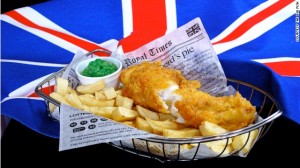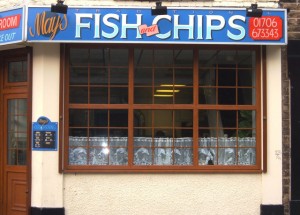ANNALS OF FOOD HISTORY
What could be more quintessentially British than fish and chips? When an English professor challenged the common wisdom, he was attacked for being unpatriotic. Panikos Panayi, who teaches at De Montfort University in Leicester, walked into a landmine when he reported on findings from his book, Spicing up Britain: A Multicultural History of British Food. The national dish, he said, was a mixture of “French frites with Jewish fish dishes.” Sixteenth century Sephardic Jews introduced fried fish to England, he contended, supporting an argument made by Claudia Roden, the English historian of Jewish and Middle Eastern food. Jews, already fish lovers, who did not cook on the Sabbath, embraced fried fish served cold. After visiting England in the late eighteenth century, Thomas Jefferson wrote that he ate “fried fish in the Jewish fashion.”
Panayi’s revelations were greeted with a media uproar. The Daily Star headlined “Le Great British Feesh and Cheeps: Its Frog Nosh Claims Prof.” “Know Your Enemy,” a pro-Nazi website excoriated the scholar.
Panayi, who seemed surprised at the venom he had stirred up, commented that fish and chips was one more example of the familiar process of culinary assimilation. “Over time it has become anglicized,” he pointed out. “It has almost become part of Britain.” He might have added that chicken tikka was rapidly becoming a contender for the title of national dish.
For more insight on the controversy, I turned to a work of food scholarship that had once caught my attention. John Walton’s book, Fish and Chips and the British Working Class, documents the history of a very English business, but also one fed by various ethnic tributaries. The shop was first and foremost a working class institution. Catering to workers in London and in the northern mill towns of Yorkshire and Lancashire, the shops burgeoned during the expanding industrial age of the late nineteenth and early twentieth centuries. By 1910, according to an estimate cited by Walton, Britain boasted 25,000 chippies.
The shops provide factory hands with an inexpensive and filling dinner break. Greater pocket money enabled workers and their families to have a night out at the local chippie. “Respectable” voices expressed horror at the trend. The eateries, some warned, were shabby, dirty, and unsanitary. Fish and chips and mushy peas, it was said, did not constitute a nutritious diet.
The British enterprise required outside assistance. In London, Jewish merchants launched fish and chips shops in the East End. The immigrant owners, who substituted olive oil for the typical English lard, primarily sold to their fellow ethnics. By 1933, Jews were at the helm of 148 chippies in London alone. When the immigrants moved north to Golders Green, Finchley, and other neighborhoods, fish and chips shops followed.
Fish battered with matzo meal was a Jewish signature. In their new communities, the ethnics would patronize non-Jewish shops as long as they met such cultural requirements. Booba’s, a Turkish Cypriot-owned restaurant in Edgware, a largely Jewish suburb, featured both fish fried with matzo and hummus and taramasalata. [In a photo of Booba’s storefront on the visitlondon.com website, you can see the words “fish in matzo meal” emblazoned on the window.]
In Scotland and Ireland, Italians were ground breakers in fish and chips. Former farmers from Italy who emigrated from poor agricultural communities found jobs as vendors of religious statuettes, ice cream, and other products. In Scotland, they moved up to owning small fish shops, sometimes in combination with ice cream bars. The new proprietors, who pioneered the businesses in Glasgow, were invading the market in Edinburgh, one alarmed local reporter wrote in 1914: “The wily Italians found out that there was much more money in this class of shop, than in the ice cream variety, and so they have gradually wormed their way into the business.” Like Greek restaurant owners in the U.S., the Italians soon fanned out from Edinburgh and Glasgow to smaller cities and towns.
In Ireland, the Italians dominated the early fish and chips shops. In Dublin, a survey found that most of those businesses in 1909 were operated by these immigrants. Popular shops in Ireland had names like Macari, Borza, Casolia, Marsellas, and Aprise, all families who had emigrated from the same part of Italy.
Another ethnic wave changed the fish and chips landscape in the post-war era. Capitalizing on their colonial ties, Greek Cypriots flocked to England. The independently minded settlers carved out a niche in the fish and chips trade. The owners and their close-knit families saw a chance to get ahead in a business whose demanding regimen was less and less attractive to native Britishers. Panikos Panayi, the ethnic food historian, who is of Cypriot background, found that despite the tiny community of a few hundred of his compatriots in his hometown of Leicester, almost all the chippies were owned by them.
The Cypriot dream of success through fish and chips is captured in Papadopoulos and Sons, an English film my wife Peggy and I recently saw on Netflix. Harry Papadopoulos, who starts his business career in the family business, Three Brothers Fish and Chips, goes on to build a highly profitable Greek food corporation, and finds his family a luxurious mansion. During the financial meltdown, he loses his shirt and is forced to return reluctantly to his fish and chips venture. One of the movie’s subplots involves a budding romance between the son of a Turkish Cypriot who owns a kebab shop across the street and Harry’s daughter Katie. Hassan, the Turkish businessman, is resentful that he must compete with Harry, who is not only selling fish and chips but also kebabs.
Fish and chips knows no ethnic boundaries. The late night pub crowd hungry for a “Chinese” will find many a takeaway offering both shrimp fried rice and fish and chips.
September 2014









